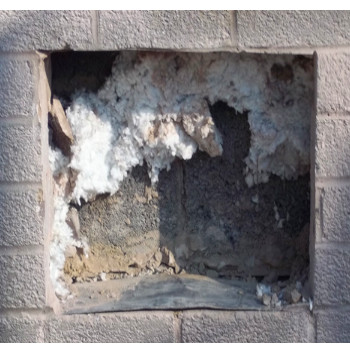
CAVITY WALL PROBLEMS? ALL YOU NEED TO KNOW*
Over the past 35 years, about eight million homes in the UK have been retrofitted with wall insulation to improve energy efficiency. Although properly installing suitable wall insulation in an appropriate property does reduce heat loss, thousands have blamed insulating wall cavities for triggering mould and damp inside. If you read this article, you probably already dealing with those problems.
Most cavity wall problems are the result of installation and maintenance issues. It is always best to prevent the problem from occurring rather than rectifying the problem afterwards.
In this guide, we will lay out most problems related to cavity walls. We will go into the common signs of cavity wall problems in more detail later in the guide. This will help you to make an informed decision and to spot problems before they become serious.
 TABLE OF CONTENTS
TABLE OF CONTENTS
CAVITY WALL PROBLEMS?. ALL YOU NEED TO KNOW
DAMP
The three most common kinds of damp in cavity wall are rising damp, penetrating damp and condensation.
1. RISING DAMP
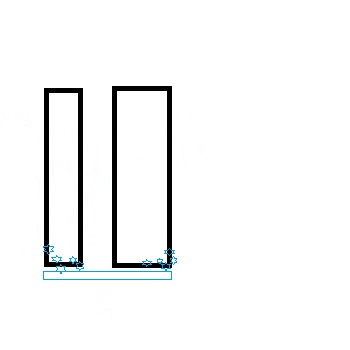 Rising damp is caused by ground water moving up through the wall materials. In other words means, it is caused by the same movement of ground water up through the brickwork by capillary action.
Rising damp is caused by ground water moving up through the wall materials. In other words means, it is caused by the same movement of ground water up through the brickwork by capillary action.
Most contain some moisture but the damp is usually stopped by a damp-proof course (DPC).
Buildings should have some form of barrier installed at the lower level of the cavity wall to prevent water rising up in this way. It is called a damp proof course (DPC). These can be made of water-resistant materials such as bitumen and plastic depending on the period the property was built. Sometimes these physical DPCs may fail over time. If you don’t have a DPC or there is evidence that it has failed then there is nothing to prevent the water from traveling up your wall.
In fact, rising damp can be a serious problem, as if left untreated it can lead to structural issues, not to mention it is not good for your health, making some respiratory conditions much worse.
A visible stain often appears on the wall in the form of a tide mark at the point where the ground water has reached. You may also see salts blooming on the internal surface. In most cases, these tide mark stains appear up to a metre above the skirting board. In some very rare cases, water can travel beyond this point. Masonry containing a high proportion of fine pores will allow the water to rise higher than one with less pores.
The most effective and economical way to treat rising damp is with a damp proofing chemical injection. As it cures, it creates a powerful water-repellent barrier and a new chemical DPC that stops water from rising up the wall.
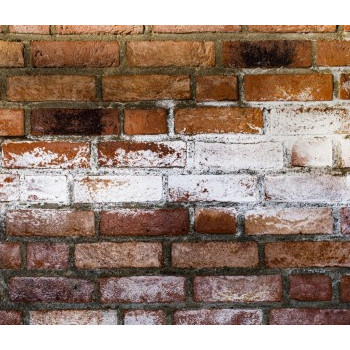
Picture credit: wacker.com
2. PENETRATING DAMP
 Penetrating damp is caused by water permeating through external walls, mostly horizontally. Penetrating damp is usually caused by structural problems in a building, such as faulty guttering or roofing and is increased by wind and rain loadings.
Penetrating damp is caused by water permeating through external walls, mostly horizontally. Penetrating damp is usually caused by structural problems in a building, such as faulty guttering or roofing and is increased by wind and rain loadings.
It can come from the outside in the way of wind blown rain, it can be driving through the brickwork through the mortar everywhere else and it can be appearing on the inside.
If you got a ‘clear’ cavity, that water is going to drip down on the inside into foundations and soak away. It would ake quite a lot of water coming through that elevation before you start to see any problems on the inside. If your walls are in reasonable condition and you don’t live in an exposed location such as top of the hill, it is unlikely that it's going to be soaking that cavity wall from the outside.
If you do have that problem you can simply treat the wall with sealer which is very, very effective. The wall will become drier and warmer on its own even without cavity wall insulation. You will find benefit because dry walls are a lot better insulation then wet walls.

Picture credit: thedampbuster.com
3. CONDENSATION
 You may have heard of the condensation problems too. Condensation is caused by moist air condensing on poorly insulated cold walls, mainly during winter months. Condensation occurs when warm air collides with cold surfaces, or when there's too much humidity in your home. When moisture in the air comes into contact with a colder surface, such as cavity wall, the warm air is unable to hold the same amount of moisture and the water is released onto the colder surface, creating tiny droplets of water to appear.
You may have heard of the condensation problems too. Condensation is caused by moist air condensing on poorly insulated cold walls, mainly during winter months. Condensation occurs when warm air collides with cold surfaces, or when there's too much humidity in your home. When moisture in the air comes into contact with a colder surface, such as cavity wall, the warm air is unable to hold the same amount of moisture and the water is released onto the colder surface, creating tiny droplets of water to appear.
Condensation can be exacerbated by inadequate ventilation and an increased heating need due to poor thermal protection. Condensation may be a problem for you if you insulate the house and don't ventilate. In fact, in order to get a grant, it is required to take 25mm off the bottom of all the doors and put trickle vents on all your windows. Once you’ve had this cavity wall insulation done you really need to keep those moisture levels under control. This can be achieved through an extractor fan, as long as that extractor fan is powerful enough. Otherwise, excess moisture in the air will surpass the dew point, creating condensation and wet surfaces. If wet walls and streaming windows occur over a prolonged period of time, other signs will start to appear such as damp patches on walls, peeling wallpaper and ultimately black mould growth.
It has been published that 40 percent of houses whose cavity walls have been filled with blown mineral fibre suffer from gaps in the insulation, and it is these voids which cause condensation and black mould on the walls inside. Because, in a house which has been only partially insulated, the temperature still rises, and with it, the humidity - the amount of water vapour held in the air. Any remaining cold spots will therefore experience more condensation than before. Common areas for condensation and black mould growth are near ground level, between windows, and at ceiling level in upstairs bedrooms.
Picture credit: wallcavityclaims.co.uk/
CAVITY WALL DAMP PROBLEMS
1. WALL TIES CORROSION
 Inside your cavity wall you have things called wall ties. Poorly installed wall ties can act as a moisture route across the cavity. Ties should always be horizontal and never angled down towards the inner leaf.
Inside your cavity wall you have things called wall ties. Poorly installed wall ties can act as a moisture route across the cavity. Ties should always be horizontal and never angled down towards the inner leaf.
Deposits of mortar on wall ties (snots during construction), obstructions and mortar extrusions on the inside surface of the outer leaf, predominantly at bed joints, can transmit moisture to the inner leaf. In most cases wall ties get damp, water simply tracks across. It gets into the internal skin and eventually you see little damp patches. However, that is reasonably rare.
There are other concerns - wall ties are vital for the structural integrity of a cavity wall, as they hold the inner and outer leaves of masonry together. Being made of iron or steel, they will inevitably rust eventually, but in dry conditions they should last for many years. Where metal wall ties are used and the cavity insulation is itself wet, then clearly it will be holding moisture in close contact with the wall ties, and hence accelerate their corrosion.
When persistently damp however, they can corrode much quicker, and replacing them is a costly and time-consuming process, involving cutting out dozens of individual bricks from the outer leaf. Replacing corroded wall ties becomes much more difficult in a building with cavity wall insulation, as the insulation itself has to be removed around each tie, and then replaced afterwards.
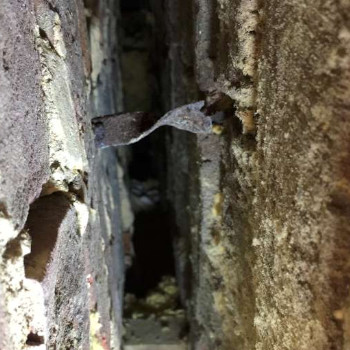
Picture credit:coastalwallties.co.uk/
2. CAVITY WALL INSULATION
If your cavity walls were wrongly insulated, this could cause you problems down the line. In fact, filling any cavity with insulation will always hold the risk that moisture will be able to cross to the inside wall, whatever the insulation material due to a range of factors. There is the quality issue, with the possibility that the installation will be less than perfect, leaving voids and air pockets, these will lead to 'cold spots' on the internal walls attracting condensation and mould.
Recent cavity insulation material is usually rigid foam boards, which are intrinsically waterproof, or mineral-wool or glassfibre "batts" (panels), where vertical aligned fibres run penetrating rainwater downwards in the cavity, reducing the chance of moisture penetration across to the inner leaf.
This type of installation can be partial fill or full fill of the cavity width. In partial fill the insulation is fixed to the inner leaf, leaving a narrow cavity to intercept any rainwater that penetrates the outer wall.
Building Research Establishment (BRE) research has found that single-leaf brick walls always leak when exposed to wind-driven rain. The leakage occurs at the vertical joints between adjacent bricks, because of drying shrinkage, settlement cracks in the mortar, common natural occurrences in buildings.
There can be an increased risk of rain penetration if a cavity is fully filled with insulation, i.e. moisture is able to transfer from the outer to the inner leaves resulting in areas of dampness on internal finishes.
Rainwater, under certain driving rain conditions, can penetrate the outer leaf of masonry leading to wetting of the cavity insulation, a reduced thermal performance and damage to internal finishes.
Problems related to damp from cavity wall insulation are predominantly due to the poor installation or the lack of understanding that the property should not be fitted with cavity wall insulation in the first place. They are buildings where cavity wall insulation should never have been installed. Walls not suitable for insulation are:
- Walls with a cavity of less than 40mm
- Walls particularly exposed to driving rain
- Walls in a poor structural condition
- Timber frame walls – these often have a brick outer leaf and look like cavity walls
- Metal framed buildings and walls
- Walls with lots of cavity bridges
- Walls with a parapet that does not have a cavity tray
- Walls more than 12m high
You should only consider cavity wall insulation if:
- Your home has unfilled cavity walls made of brick.
- The cavities are at least 2 inches wide.
- The brickwork or masonry is in good condition.
- Your external walls are accessible. If some are joined to a neighboring house, the installer will need to insert a cavity barrier, which could add to the costs. Installers may also be reluctant to work around garages, conservatories or extensions.
- Your home is less than 12 metres (about 4 storeys) high.
- Your internal walls are dry. Wet wall insulation is worse than no wall insulation, so if you have any damp patches, you’ll need to get the cause sorted out before installing insulation. For the same reason, cavity insulation is not suitable if the walls are regularly exposed to driving rain.
- There are no areas of steel or timber-framed construction.
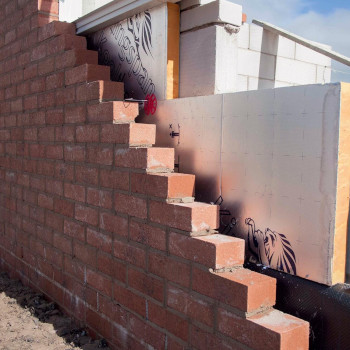
Picture credit: self-build.co.uk
3. CAVITY TRAYS and DPCs
Inaccurately installed cavity trays and DPCs may result in rain penetration problems. Any horizontal DPC should protect the full width of each leaf and not project into the cavity where it can gather falling materials. Vertical DPCs should be secure in all jambs to prevent wilting and should protrude at least 25mm beyond the closure into the cavity. Effective stop ends should be permanent to prevent water running off the end of the tray into the cavity and drainage weep holes formed in the outer leaf, at centres not exceeding one metre
4. INADEQUATE VENTILATION
When you insulate a house, you will be making it more airtight, so installers must ensure existing airflow is maintained and additional ventilation fitted where necessary.
*All the information provided in the content published on Insulationgo blog is for informational and educational purposes only. Insulationgo LTD makes every effort to ensure the accuracy and timeliness of the content, but we do not assume any responsibility for any errors or omissions.
The information presented on this blog should not be considered as professional advice or a substitute for consulting relevant experts. Before making any purchase decisions or taking action based on the information presented here, it is strongly recommended to contact the product manufacturer directly to verify the details and ensure its suitability for your specific needs.
By using this blog, you acknowledge and agree that Insulationgo LTD shall not be held liable for any damages, losses, or inconveniences arising from the use or reliance on the information provided herein. This limitation of liability applies to all users of the blog, including but not limited to visitors, readers, and subscribers.










































































































